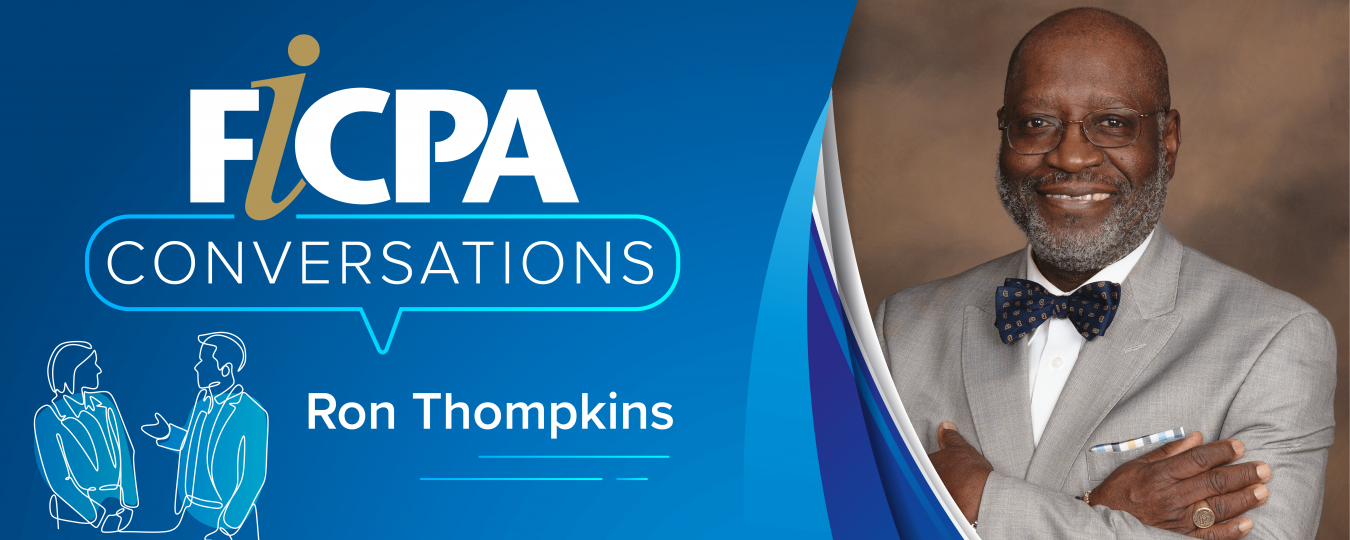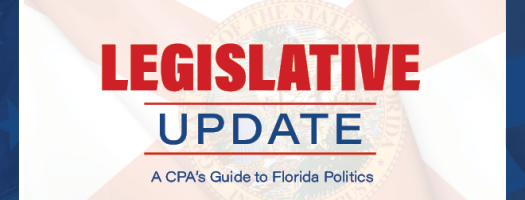
FICPA Conversations is a new Q&A series offering commentary from key individuals in the profession who have unique stories to tell and perspectives to share.
In honor of Black History Month, we’re kicking off FICPA Conversations with Ron Thompkins, the first black president of the FICPA.
With nearly 50 years’ experience in accounting, Ron currently serves as national quality control partner at WatsonRice.
Now splitting his time between Miami and Denver, he remains involved with the FICPA as trustee emeritus of the FICPA Scholarship Foundation – the upcoming 1040K Run remains near and dear to his heart – and as a director of the Florida CPA/PAC - South.
Here's Ron's story and our discussion about diversity, equity and inclusion in the accounting world. (This conversation has been edited and condensed for clarity.)
Tell us about your journey as a CPA. What did the accounting industry look like when you graduated from Howard? How were you able to navigate that world? And who are some of the people who helped guide you along the way?
I started in October 1972 with what was at that time Haskins & Sells and today is Deloitte. Out of all the issues we have with diversity and inclusion today, my early journey back in 1972 was one of excitement. I met some incredible people. At that time, as you probably would expect, there were not a whole lot of people of color in the profession. When I joined the Miami office, I think I was the third African American to ever work there. It’s pretty much a product of my upbringing that I never considered myself different. I immediately made sure to make myself part of the team.
I was incredibly blessed to have people who took me under their wings. They made sure that I had the best training and always included me in social functions after work. Ken Neighbors, who was a senior accountant at the firm, he was really instrumental in my growth. The very first job I ever worked on, I worked with him. I didn’t know it at the time, but he was considered one of the top seniors in the firm. He included me on every job he could. I learned a lot, I had a lot of fun, and as a result my development at the firm was incredible. I got some very good assignments – Florida Power & Light, the Deltona Corporation, the University of Miami. I had some blue-chip clients in the early 70s, when that was highly unusual for a person of color.
At the time I left the firm, I was a manager. My growth was, in hindsight, more than I expected. I did see at that time, even though it was not that promising, a clear path to partnership. Being a person who always wanted more, I came to the conclusion that partnership would not be as rewarding as I thought it would be. When I was approached by these two buddies of mine about starting our own practice, I felt that was more of a challenge than even making partner at a national firm. We launched our practice on Aug. 1, 1980. When we had the opportunity to merge with the firm I’m with now, which was much larger and much more diversified, we did not hesitate to take them up on the offer.
The journey that I’ve had since has allowed me to do some things that are pretty important to me. I’ve served on the Minority Initiatives Committee of the AICPA, prior to it becoming the National Commission on Diversity and Inclusion. The highlight of my career has always been 2000-01, when I became the president of the FICPA.
When I was at Haskins & Sellers, Lyn Conlon was a partner and very active in the FICPA. At the time, when you did your orientation paperwork, you also got an application for membership with the FICPA. It was not optional – you had to attend the monthly meetings. My take on that was: If I have to be here, let me get involved. So I got involved with committees: A&A, Peer Review, Professional Ethics, and a few others.
After being president of the FICPA, I had the opportunity to become a member of the Board of Directors for the AICPA. That took my career to another height.
The profession has been very good to me. Out of my four kids, I had a pleasant surprise when I took my daughter Carshena to college; she told me she wanted to major in accounting. All of my children when they were younger would work in the firm from time to time, but none of them expressed an interest in doing it for a living. Carshena was my big surprise. She’s now the managing partner of the Miami office of the firm.
The profession still has a long way to go to reach the levels we want it to in terms of diversity and inclusion, but I’ve enjoyed my journey for the almost 50 years I’ve been in it.
Becoming the first black president of the FICPA, what did that distinction mean to you at the time and how do you look back on your tenure?
As monumental as it may be to people of color, it was really a non-event for me, because I felt pretty much accepted all the time. For 14 years, I had been involved at the FICPA at different levels. The way I was welcomed as president, I had the full cooperation of the board. All the chapter presidents and officers fully accepted me. I had no pushback on any initiative that I wanted to put in place.
Prior to becoming president of the FICPA, I was president of the FICPA Scholarship Foundation. A lot of the chapter officers already knew me. When I went out to chapters, I was welcomed and accepted.
It was just a labor of love. I had an enjoyable experience.
There was a recent study produced by the Association of Accountants and Financial Professionals in Business and the California Society of CPAs that examines the Diversity Gap in the industry. One of the statistics cited in the report is that “for every 10 of the profession’s most senior leaders, nine are white, eight are male and very few identify openly identify as LBGTQIA.” Considering the leadership roles you’ve taken on in your career, can you discuss the importance of diversity not just throughout the industry but particularly at its highest levels?
One of the reasons I ended up in Denver is Sharron Lassar, who is the current head of the Colorado Society of CPAs and also a longtime friend. She and I were involved with diversity and inclusion for a number of years. When I was president of the FICPA, she was one of my board members, and we really became close. Back in 2015, she asked me to come teach at the University of Denver. I assumed it was just be for a short time, and it was always one of the things on my bucket list, to teach at the collegiate level. From 2015-18, I had the opportunity to teach, and that became an incredible experience.
One of the courses was a graduate class on leadership, which I co-taught with another guy from PwC, and we introduced the students to diversity and inclusion. We were able to emphasize that when you look at the future and the organizations that are really on the cutting edge and leading their industries, they all have one common theme: They have diversity and inclusion as a core component of their strategy. That allows them to see new opportunities for growth. Companies that don’t have diversity and inclusion as part of their core strategy are probably going to lose out on those opportunities for growth, for the future, because they aren't focused on people who don’t think the way they do. They just don’t think out of the box.
There’s an excellent video presentation we used to show our students, with Bob Mortiz from PwC and Mellody Hobson of Aerial Investments. The two of them have an excellent talk on the importance of diversity and inclusion in corporate America.
Finally, diversity, equity and inclusion are all words we use often, but they can mean different things to different people. How do you think about these concepts, and what advice would you give industry leaders who are looking to promote positive change?
What made my journey in the profession is that I intentionally went out of my way to get to know people who did not look like me or come from backgrounds like I did. That helped me tremendously.
Diversity and inclusion can just be buzzwords, but once you actually put them into play and they're supported by the leaders of an organization, the dividends are tremendous.
When you think about Gen Z and the future and what the world is going to look like, it’s become a prudent business decision to start making sure your workforce and talent force is more diversified and inclusive.


